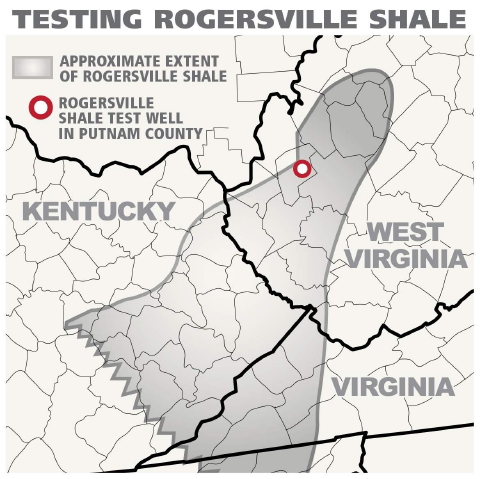THE NEXT BIG THING? ROGERSVILLE SHALE DRILLING - Strata Rests Under Calhoun, Roane And Wirt

(Charleston Gazette Graphic)
Gas companies continue to develop the Marcellus Shale in Northern West Virginia, despite the glut in natural gas and low prices, most recently the State of WV, which owns the Ohio River along its border, issuing drilling leases in the river for horizontal drilling and fracking.
Drillers are likely upbeat over the river drilling, because millions of gallons of water are used in fracking, often costly to haul or lay waterlines to land-based drilling.
Environmentalists are opposed to Ohio River drilling because millions of water customers rely on the river water for sustenance.
Controversial horizontal drilling rights with eminent domain features was barely beaten back during this year's West Virginia legislature.
Now comes the introduction of a new layer of gas - the Rogersville Shale, with a test well to be drilled in Putnam County, hyping yet another natural gas boom.
Marcellus is located around 5,000 feet underground, the Rogersville can be anywhere from 9,000 to 14,000 feet below the surface.
Rogersville strata extends to Calhoun, Roane and a sections of Wirt.
Cabot Oil and Gas will likely drill a vertical test well into the Rogersville Shale in Mason County, a relatively unexplored deep-shale formation that underlies parts of northeast Kentucky and a few West Virginia counties.
Cabot's exploration comes on the heels of two exploratory wells by another company just over the state line in Lawrence County, Kentucky with the gas developers having not released production data from those wells.
The recent exploration of the Rogersville formation comes at a time when horizontal drilling coupled with hydraulic fracturing have unlocked previously unattainable oil and natural gas reserves in West Virginia and the nation.
The glut in natural gas and low prices might forestall any immediate development of Rogersville in the region, but the exploratory wells could usher in a new wave of development.
Cabot already has substantial lease holdings in the area â including more than 600 tracts held by existing gas wells.
David Harris, the head of the Kentucky agency's Energy and Minerals Section, said the formation tends to be much deeper in West Virginia than it is in Kentucky and that the extreme depths of the Rogersville likely would make production costs higher than a well drilled into the Marcellus.
Harris said the makeup of the gas in Kentucky and West Virginia is different.
In Kentucky the gas produced could include natural gas liquids â butane, ethane and propane â which can be separated off and sold for additional profit.
In West Virginia the gas will largely consist of pure methane, he said.
"It's been a very closely guarded play, so far," Harris said.
The companies in Kentucky will not have to reveal how much natural gas the Rogersville wells are producing until January 2016.
The Cabot well in Putnam County, production data could be available a year after the well is completed.
Meanwhile, in West Virginia, royalty holders are constantly approached by companies over leasing their gas rights, with offers that vary thousands of dollars an acre.